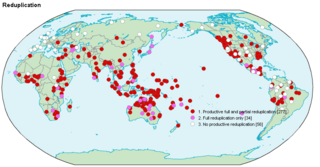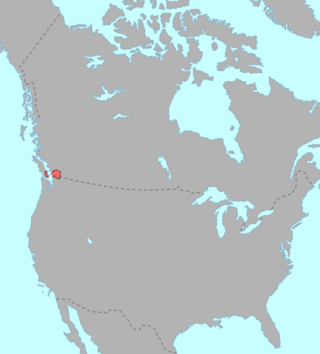In linguistics, an affix is a morpheme that is attached to a word stem to form a new word or word form. The main two categories are derivational and inflectional affixes. The first ones, such as un-, -ation, anti-, pre- etc, introduce a semantic change to the word they are attached to. The latter ones introduce a syntactic change, such as singular into plural, or present simple tense into present continuous or past tense by adding -ing, -ed to an English word. All of them are bound morphemes by definition; prefixes and suffixes may be separable affixes.
Morphological derivation, in linguistics, is the process of forming a new word from an existing word, often by adding a prefix or suffix, such as un- or -ness. For example, unhappy and happiness derive from the root word happy.
An infix is an affix inserted inside a word stem. It contrasts with adfix, a rare term for an affix attached to the outside of a stem, such as a prefix or suffix.

In linguistics, reduplication is a morphological process in which the root or stem of a word or even the whole word is repeated exactly or with a slight change.

Halkomelem is a language of various First Nations peoples of the British Columbia Coast. It is spoken in what is now British Columbia, ranging from southeastern Vancouver Island from the west shore of Saanich Inlet northward beyond Gabriola Island and Nanaimo to Nanoose Bay and including the Lower Mainland from the Fraser River Delta upriver to Harrison Lake and the lower boundary of the Fraser Canyon.
Proto-Indo-European verbs reflect a complex system of morphology, more complicated than the substantive, with verbs categorized according to their aspect, using multiple grammatical moods and voices, and being conjugated according to person, number and tense. In addition to finite forms thus formed, non-finite forms such as participles are also extensively used.

Quechan or Kwtsaan, also known as Yuma, is the native language of the Quechan people of southeastern California and southwestern Arizona in the Lower Colorado River Valley and Sonoran Desert. Despite its name, it is not related to the Quechua language of the Andes.
Comox or Éyɂáɂjuuthem is a Coast Salish language historically spoken in the northern Georgia Strait region, spanning the east coast of Vancouver Island and the northern Sunshine Coast and adjoining inlets and islands. More specifically, ʔayajuθəm was traditionally spoken in Bute Inlet, in Squirrel Cove, and in Sliammon, located in the area now known as Powell River.
The Ojibwe language is an Algonquian North American indigenous language spoken throughout the Great Lakes region and westward onto the northern plains. It is one of the largest indigenous language north of Mexico in terms of number of speakers, and exhibits a large number of divergent dialects. For the most part, this article describes the Minnesota variety of the Southwestern dialect. The orthography used is the Fiero Double-Vowel System.
Reduplication in Russian is used to intensify meaning in different ways.
This article provides a grammar sketch of the Nawat or Pipil language, an endangered language spoken by the Pipils of western El Salvador and Nicarao people of Nicaragua. It belongs to the Nahua group within the Uto-Aztecan language family. There also exists a brief typological overview of the language that summarizes the language's most salient features of general typological interest in more technical terms.
While other word categories in Ilocano are not as diverse in forms, verbs are morphologically complex inflecting chiefly for aspect. Ilocano verbs can also be cast in any one of five foci or triggers. In turn, these foci can inflect for different grammatical moods.
Pohnpeian is a Micronesian language spoken as the indigenous language of the island of Pohnpei in the Caroline Islands. Pohnpeian has approximately 30,000 (estimated) native speakers living in Pohnpei and its outlying atolls and islands with another 10,000-15,000 (estimated) living off island in parts of the US mainland, Hawaii and Guam. It is the second-most widely spoken native language of the Federated States of Micronesia the first being Chuukese.
This article describes the grammar of the Khmer (Cambodian) language, focusing on the standard dialect.

Wagiman, also spelt Wageman, Wakiman, Wogeman, and other variants, is a near-extinct Aboriginal Australian language spoken by a small number of Wagiman people in and around Pine Creek, in the Katherine Region of the Northern Territory.
This article presents a brief overview of the grammar of the Sesotho and provides links to more detailed articles.

In linguistic morphology, inflection is a process of word formation in which a word is modified to express different grammatical categories such as tense, case, voice, aspect, person, number, gender, mood, animacy, and definiteness. The inflection of verbs is called conjugation, and one can refer to the inflection of nouns, adjectives, adverbs, pronouns, determiners, participles, prepositions and postpositions, numerals, articles, etc., as declension.
Malay grammar is the body of rules that describe the structure of expressions in the Malay language and Indonesian. This includes the structure of words, phrases, clauses and sentences. In Malay and Indonesian, there are four basic parts of speech: nouns, verbs, adjectives, and grammatical function words (particles). Nouns and verbs may be basic roots, but frequently they are derived from other words by means of prefixes and suffixes.
Martu Wangka, or Wangkajunga, is a variety of the Western Desert language that emerged during the 20th century in Western Australia as several indigenous communities shifted from their respective territories to form a single community.




